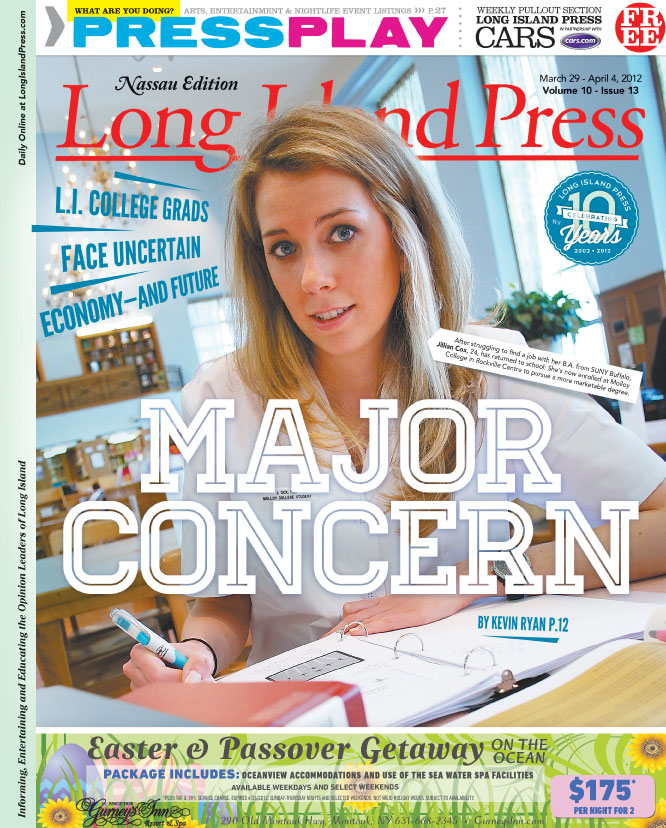The Kay family used to be the ones who volunteered to wrap and deliver gifts for needy families. But the couple from Holtsville found Long Island to be too expensive to raise their two young children after Mr. Kay was laid off from his Nassau County job and Mrs. Kay was diagnosed with rectal cancer. They packed up and moved south, to the sunny promise of better days in Florida. Once there, the cruel hand of fate dealt them another blow, and a housing scam brought them to their knees. Now, they are back on LI, they had to sell most of their belongings to afford an apartment in Shirley and need help themselves.
“It’s just been a nightmare,” says Mr. Kay, who asked that his first name not be used.
The harsh realities of the recession forced the family to ask for assistance from the charity that they had volunteered for, but now that group is struggling to keep up with the pace of incoming calls. From the biggest local food bank to The Salvation Army, health-focused charities to homegrown annual holiday toy drives—not to mention the homeless shelters—the stories are all the same: The donors have become the needy, and those who can still give are often cutting back. The poor and working poor are no longer the only ones on line, as working-class and middle-class families now find themselves out of options and looking for help.
Although charity workers count on the holiday season benevolence boost, those who’ve weathered the recession still face a gap between donations and the disadvantaged that will continue widening long after the Thanksgiving Day soup-kitchen aides lose the spirit of volunteerism come January.
“I don’t think anyone can say that they aren’t impacted by a not-for-profit,” said Kenneth Cerini, a Certified Public Accountant and managing partner of Cerini & Associates, which released the annual Long Island Not-for-Profit Survey just in time for Philanthropy Day at the Long Island Marriott in Uniondale on Nov. 20. But for a sector that has traditionally been known for its optimism in the face of adversity, there are troubling signs, Cerini said.
Of the more than 3,000 nonprofits on Long Island, 5 percent—or about 150 organizations—expect to close up shop in the not-too-distant future. Ten percent are in the process of merging operations with other nonprofits and 15 percent are considering doing the same, the survey found. The majority reported an increase in demand while 77 percent blame funding losses on the economy. Those who lost money in the Madoff scheme won’t talk publicly about it. Locally, two notable nonprofits have gone under this year: The Inter-Media Arts Centre in Huntington and the Bideawee animal shelter in Wantagh.
Ana Marie Thigpen, director of the Long Island Center for Nonprofit Leadership at Adelphi University, says that nonprofits are losing considerable amounts of money from individuals who have to reevaluate their finances. People and companies can no longer afford to donate when they themselves have significant financial problems, Thigpen says. She explains that a prolonged recession could cause permanent financial damage to nonprofits.
“Funding may never come up to the levels that they were in the past,” Thigpen says.
Frustrating? Yes. Surprising? No. The survey’s finding paralleled the numerous studies focusing on nonprofits coast to coast. Some groups with decades (and, in some cases, more than a century) of charitable giving under their belts are on the brink. And that’s a scary thing for all involved.
“We have people who never, ever, ever come to see us for service, who used to volunteer with us, who are coming for help for the first time, and for a lot of those folks, that is a horrifying feeling,” says Envoy Charles Roberts, Suffolk County area coordinator for The Salvation Army.
“It’s really scary when our donors become our recipients,” says Melissa Doktofsky, founder of Huntington-based Toys of Hope, which provides gifts, clothes and toiletries to needy families across LI. “It’s really a call to action.”
Turkey Time
Robin Amato saw a dire situation at the Harry Chapin Food Bank in Hauppauge this summer—well before the holiday season.
“Barrels that used to be full of food are now half empty,” says Amato, director of development for Long Island Cares, the nonprofit organization that runs the Harry Chapin Food Bank. She says that in the last year she has seen the number of corporate and individual donations to the food bank drop 47 percent, about 531,000 fewer pounds than last year. By the end of this year she expects to have seen about 100,000 more people seeking food than last year.
Randi Schubin Dresner, president of Island Harvest, which relies on restaurants and supermarkets to donate excess food, says that some corporations that had community outreach departments specifically devoted to helping nonprofits have done away with those initiatives. Not that the food rescue group hasn’t tried to fill that gap.
“We’ve had more food drives but less donations,” says Dresner, who has had to come up with a few creative solutions to close Island Harvest’s financial gap. The group reports a 35-percent spike in need amid a 15-percent drop in donations. Still, the group hopes to donate 25,000 turkeys for the holidays.
“In one of the wealthiest counties in America, a lot of people don’t realize there’s hunger,” says Donald Miller, spokesman for Island Harvest. The group conducted a survey in 2006 that found 260,000, or about 10 percent of the populations of Nassau and Suffolk counties, relied on the organization.
If there’s a silver lining for food banks and organizations serving the homeless, it’s that they tend to get more support because they are seen as vital services. In January, New York State shared $1 million with food banks statewide to help meet the need.






